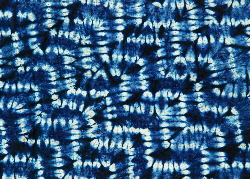|
 Prepare the indigo vat Prepare the indigo vat
1) Pour about 2½ litres of boiling water into a stainless steel saucepan or stock pot. Add 1/3 teaspoon of soda ash to the water and then add enough cold water (between 1 and 2 litres) to bring the temperature down to 45°C (if your pot is small use less water).
Don’t fill it more than ¾ full; otherwise you will not have enough space for the fibre.
2) Lower the indigo stock solution into the water, tilting the jug so that water enters the jug and the contents then flow smoothly into the saucepan. Do not pour from the jug whilst it is held above the saucepan.
Leave any undissolved indigo behind in the jug (you can grind it a bit more and use to make more stock solution). Measure the pH in the saucepan; it should be at least 9 or slightly higher, but not higher than 10.
3) Weigh the dithionite and sprinkle it onto the surface of the indigo vat. Put the lid on the pot to keep it warm (be careful when you lift the lid not to let the condensed steam drip back into the pot).
Keep the temperature constant at 45°C. This can be achieved by keeping the saucepan either near a radiator, in a basin with hot water, or by wrapping it with blankets.
4) After 30 minutes, stir the indigo vat slowly, gently touching the bottom of the saucepan so as to stir any indigo that has settled on the bottom; be careful not to introduce air to the vat. Check that the temperature is still at 45°C. Repeat this after another 30 minutes.
After about an hour and a half the solution should be a yellow-green colour with a bloom of bronze bubbles on top. Sometimes the indigo vat is ready in an hour; sometimes it takes nearly two hours. Use the indigo vat as soon as it is ready.
Troubleshooting: If the solution did not turn greenish yellow check that the pH is still between 9 and 10. If the pH is lower than that dissolve a bit more soda ash and add to the indigo vat. You can also sprinkle another 6 grams of dithionite on top of the vat. Keep the vat warm and wait for another hour.
Next;
3) Dye the fibre (opens a new page)
Back to;
- Getting started with Indigo dyeing (opens a new page)
- Prepare the fibre (opens a new page)
- Prepare the indigo stock solution (opens a new page)
Top of page
|